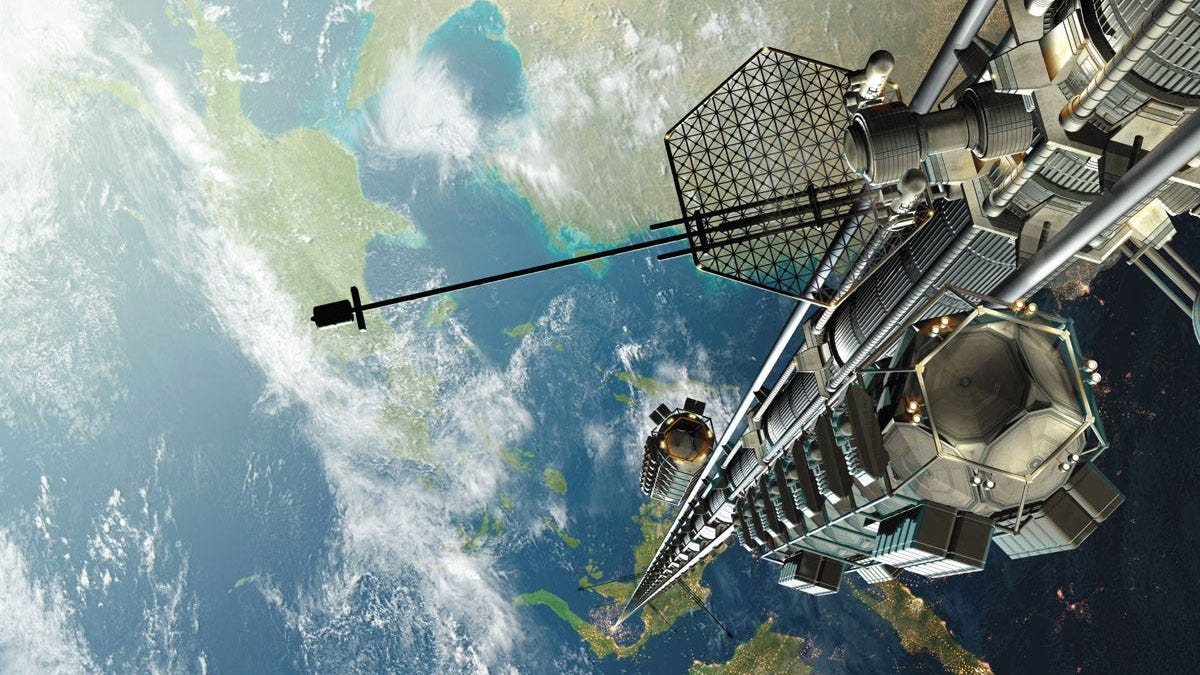sorry, but we're not getting a space elevator by 2050
A Japanese company claims they have a plan of how to build an elevator all the way into orbit by 2050. Unfortunately, that plan requires technology on par with magic.
If you’ve never been to the Skytree Tower in Japan, I highly recommend it. The views of Tokyo seemingly sprawling into infinity below are amazing, and those who are not afraid of heights can walk on a glass floor 350 meters above the streets. (Restrooms are conveniently just a few dozen steps away should you need them afterward.) But the builders of the Skytree, the Obayashi Corporation, apparently have their sights on a much taller project: a tower that would reach all the way into geosynchronous orbit. And they plan to have it ready as soon as 2050.
Technically speaking, this would be great. Instead of building rockets and using up a whole lot of fuel to launch massive payloads into space, you could just attach supplies for space stations or even small satellites to the elevator and haul them into orbit for less than a tenth of the current cost once operations scale up. Need to get a crew of astronauts back home, or launch a new crew into orbit? Give them a pressurized pod with all the necessary amenities that takes about a day or two to ferry them between the ground and space.
You get all that and more for the low, low cost of $100 billion. That’s not sarcasm. The estimated capitalization of the space industry by 2035 is $1.8 trillion, and an easy way to access any altitude from suborbital to geosynchronous will certainly expand it even further. At that point, China and the U.S. would almost certainly build their own space elevators as well, treating the matter as strategically critical.
There’s only one tiny catch. We have no idea if we can actually build one, and the plan from Obayashi relies on a nearly 36,000 kilometer cable of carbon nanotubes, which are basically rolled up sheets of graphene. This would make the cable extremely light and strong on paper, but we’ve struggled to grow carbon nanotube cables longer than 14 centimeters and that process took 26 hours. At that rate, a space elevator core will be ready in, oh… 763,209 years, give or take a few months.
Why is it so difficult to make carbon nanotubes? Because of how carbon works. Since it’s not really soluble, we can’t use any of our existing techniques for making polymers at an industrial scale. Now, this is great news for us because we’re 18% carbon and an average of 60% water by volume, so we can rest assured that our cell walls and DNA won’t dissolve, but not so great for engineers trying to make a literal mountain’s worth of it to then fly into space and somehow catch on Earth, then secure in the middle of the ocean, somewhere around the equator.
the mind-numbing logistics of space elevators
This brings us to the next problem with space elevators. Even if we somehow manage to create a 36,000 kilometer cable, how exactly do we get it into space? The heaviest lift vehicle ever flown was the Energia rocket, meant for the Soviet Buran shuttle. (Fun fact, its Zenit boosters were made at a “truck factory” in my hometown!) It was rated for placing 20 metric tons into geosynchronous orbit. A space elevator cable will be a tad heavier. Like, comparable to the mass of a small town heavier.
If you could cut that cable into neat little segments, maybe you could get it all in place with a few million rocket launches. But that would also mean that your space elevator now has several million points of failure where we have to attach each segment, and not having that is the whole reason for trying to grow a single, solid carbon nanotube cable. Which we’ll have to figure out how to launch.
Even if we do launch it, we’ll now have to catch it to a tether now holding up a cable in constant motion, one we’d need to secure deep into the sea floor around the equator, as the equator is moving the fastest out of all Earth’s latitudes, and would give a pod a little boost while going up the cable. The force of the tension would be enormous, and if something were to happen to the satellite keeping one end of the cable in orbit, the whole thing comes crashing down in a series of disasters similar to repeated impacts of small comets across the equator.
A similar disaster would also befall us if a particularly large piece of space junk hits at some point along the cable, snapping it, a terrorist act sabotages it, or a nation state uses its missiles on it during a war. And this is not to even mention a natural disaster a tether in the equator is likely to face. Hurricanes, tropical storms, water spouts, or just good, old lightning could also sever the cable, creating a whole host of headaches.
Basically, a space elevator is a great idea, but it only works if a) it can be made out a material that is utterly indestructible, b) could easily stretch for tens of thousands of kilometers, yet weigh only tens of metric tons, c) can be carefully snaked all the way down from geosynchronous orbit, then secured without any threat from satellites, or space debris, or inclement weather on Earth, and d) was both under extreme tension to mimic the dynamics of a solid building, but also had the slack to withstand impacts and the aforementioned storms.
where big dreams meet cold, hard reality
Pretty much the only material I could think of matching even some of these criteria is degenerate matter from neutron stars; extremely compressed electrons, protons, and neutrons. It would be indestructible, 100 billion times stronger than steel and a billion times stronger than carbon nanotubes. But a 36,000 kilometer cable of this “nuclear pasta” would tip the cosmic scales at roughly 2,300 times the mass of the sun and be impossible to build as the material would collapse into a black hole before it could hit the mesosphere, just 50 kilometers up.
Okay, fine, what if we tried a different idea. Instead of trying to reach from orbit down, can we build something from the ground up? It would make the logistics of getting the elevator into space far simpler as you no longer have to worry about how to catch two billion tons of carbon squeezed into a planetary scale noodle. You’ll just need to raise either eight billions of tons of steel or four billion tons of titanium into orbit, while also avoiding or diverting meteorites, space junk, any stray satellites, and withstanding the hurricanes, monsoons, and earthquakes from below.
Now, we could decide to go for broke and build a mountain into space — after a long, vicious legal battle with Disney to make sure no one refers to it as Space Mountain — under the premise that mountains can handle anything thanks to their enormous size and mass. Unfortunately, we can’t do that either because a) there’s not enough rock on the planet for that, just like there isn’t enough titanium or steel, and b) gravity will protest loudly and violently.
The tallest mountain in the solar system is Olympus Mons on Mars with a peak almost 30 kilometers above the planet’s surface. On Earth, its base would be as wide as all of Poland, and reach nearly halfway to the Karman Line, the internationally set beginning of space. It would also implode under its own weight of 2.5 million billion tons if it had the same density as our rocks. (By contrast, Mount Everest is 30 times smaller, a third of its height, and three orders of magnitude lighter.) So, we couldn’t even get halfway to the starting line of what we’d consider space with this approach.
an alternative to expedited space travel
At this point, I’ve thrown a whole lot of numbers and increasingly desperate ideas at you to basically show that a space elevator seems like a great idea at first glance, but the more we dive into the details, the more complicated and unworkable it becomes. I can imagine a future where we could grow tens of thousands of kilometers of carbon nanotubes then assemble an orbital facility to manufacture and lower a tether back to us, but once there’s a physical link between the planet and a geosynchronous facility, we will enter the same world of contingency planning and maintenance logistics that make actually keeping a space elevator operational so wildly complicated.
I could also see an alternative path for any space faring species which wants to have easy access to space but doesn’t want to deal with the complexities of an elevator to orbit: an orbital ring. Rather than launch massive payloads into space, they would only ferry crews and specialized prototypes back and forth. The actual manufacturing and launches into different orbits and beyond happen on the ring.
The ring itself would be built in orbit over thousands of years, starting with platforms similar to space stations, assembled from inflatable craft we’re already building and testing today, and supplied by asteroid mining missions that could ferry thousands of tons of resources in one shipment, their payloads limited only by deadlines. Over the centuries, these platforms would grow into manufacturing facilities, expand to build and supply more and larger spacecraft, and eventually connect with each other.
Why does this outlandish 3,000 year plan work and I’m giving a single tether so much shit? Because it flips the idea of how we’d live and build in space on it head. An orbital ring would be immune from weather on Earth and take so long to assemble that we’d have centuries to fix the space junk problem and change satellite orbits. But even more importantly, rather than rely on materials being moved and launched from Earth to avoid the costs and physical limitations of rocket launches, it would force us to look outward.
Instead of mining and sending supplies up, we could mine and explore space, send a lot of valuable resources back down, and make these platforms commercially viable and sustainable, meaning that investments in building and maintaining the ring would be a no-brainer. Billions of dollars are spent on something 10,000 kilometers over our heads, then trillions rain down in the form of processed ore, new technologies, and a whole lot of cheaply manufactured goods.
Plus, there would be the added bonuses of amazing views of the orbital ring glowing in the night sky when it’s finally large enough, and having the infrastructure for space solar power, building spacecraft that would dwarf aircraft carriers and our tallest and busiest skyscrapers, and the knowhow and machinery for starting work on a Dyson swarm should we decide to build one.
We just need to accept that all these benefits would take literal millennia of constant work and investment because there’s no such thing as a safe, reliable, and effective shortcut in space. If anything, when we look at the viability of space elevator plans, the problem with them isn’t that engineers are thinking too big when it comes to the future of space travel. It’s that they’re not thinking big and long term enough.
![[ world of weird things ]](https://substackcdn.com/image/fetch/$s_!V-uR!,w_80,h_80,c_fill,f_auto,q_auto:good,fl_progressive:steep,g_auto/https%3A%2F%2Fsubstack-post-media.s3.amazonaws.com%2Fpublic%2Fimages%2F93728edf-9a13-4b2b-9a33-3ef171b5c8d8_600x600.png)



